Bulletin #2076, Selecting Plants to Support Bees in Maine: Summary of the Bee Module Project
By Lois Berg Stack,1 Alison C. Dibble,2 and Francis A. Drummond3
1Professor Emerita, Cooperative Extension and School of Food and Agriculture, University of Maine
2Research Scientist (Retired), School of Biology and Ecology, University of Maine
3Professor Emeritus, School of Biology and Ecology and Cooperative Extension, University of Maine
All photos courtesy of A.C. Dibble
For information about UMaine Extension programs and resources, visit extension.umaine.edu.
Find more of our publications and books at extension.umaine.edu/publications/.
Table of Contents
- Introduction
- About the Bee Module Project
- Findings of the Bee Module Project
- Broad Recommendations from the Bee Module Project
- Specific Results of the Bee Module Project
- Summary
- Table 1. Bee plants, their flowering times, and the rates at which bees visited them
- Additional Resources
- Funding Resources
- Acknowledgments
Introduction
This bulletin provides new information about selecting plants for bee gardens. A plant list in Table 1 is based on four growing seasons of data from four sites in Maine. To provide a context for the Bee Module Project, we first provide some background.
Insect decline around the world includes bees, with effects due to climate change, pesticides, loss of habitat, and lack of flowers. Most of Maine’s 278 species of bees are important pollinators of native plants, field crops, and home landscape and garden plants, although 20% of Maine’s bee species are bee parasites that are not considered effective pollinators. Some bees are thriving, while a few bumble bees that were once fairly common in Maine are now hard to find or can no longer be found, such as the rusty-patched bumble bee (Bombus affinis), which is federally endangered. Some bee populations in Maine have declined in recent years, though others appear to be increasing.
Improvements to bee habitat can be easily undertaken and are likely to improve pollination around the farm or garden. As bees move from one flower to another searching for pollen, nectar, or oils, they inadvertently move some of the pollen, enabling flowers to develop into fruits. People can increase the abundance of flowers on their property, but which plants should be included? To improve the effectiveness of bee gardens one can consult lists of pollinator plants. However, not all the plants on published lists are readily available, or hardy in Maine. Some lists were developed from studies that followed only one or two types of bees for only one or two seasons, and their relevance for many kinds of bees is not known.
About the Bee Module Project
The Bee Module Project was an experiment conducted by University of Maine researchers Alison C. Dibble, Francis A. Drummond, and Lois Berg Stack, with help from students and friends listed at the end of this bulletin, from 2012 to 2015 with funding from the U.S. Department of Agriculture and others (see Acknowledgments at the end of this bulletin). The project’s goal was to provide information on which plants to include in bee gardens, to help farmers and gardeners interested in promoting bee habitat. This study involved observations of up to 90 plant species and cultivars, each during at least one of four years, at four sites in Maine (Fig. 1a). Two sites were hosted by commercial blueberry farms in Blue Hill, ME, and two were at University of Maine research farms (Rogers Farm in Stillwater, ME, and Blueberry Hill Farm in Jonesboro, ME). Each garden contained 36 1-square-meter planting spaces separated by 1-meter-wide paths (Fig. 1b). We studied most plants, including shrubs, herbaceous perennials, and annuals, at all four sites (Fig. 1c). We chose plants for the study based on published recommendations; suggestions from stakeholders like home and professional gardeners, natural area managers, and fruit and vegetable growers; and on our own observations and interests. From our long list of plants, we selected those that were available in the nursery trade, that we could grow into seedlings in a greenhouse to transplant outdoors, or that we could direct-seed outdoors.



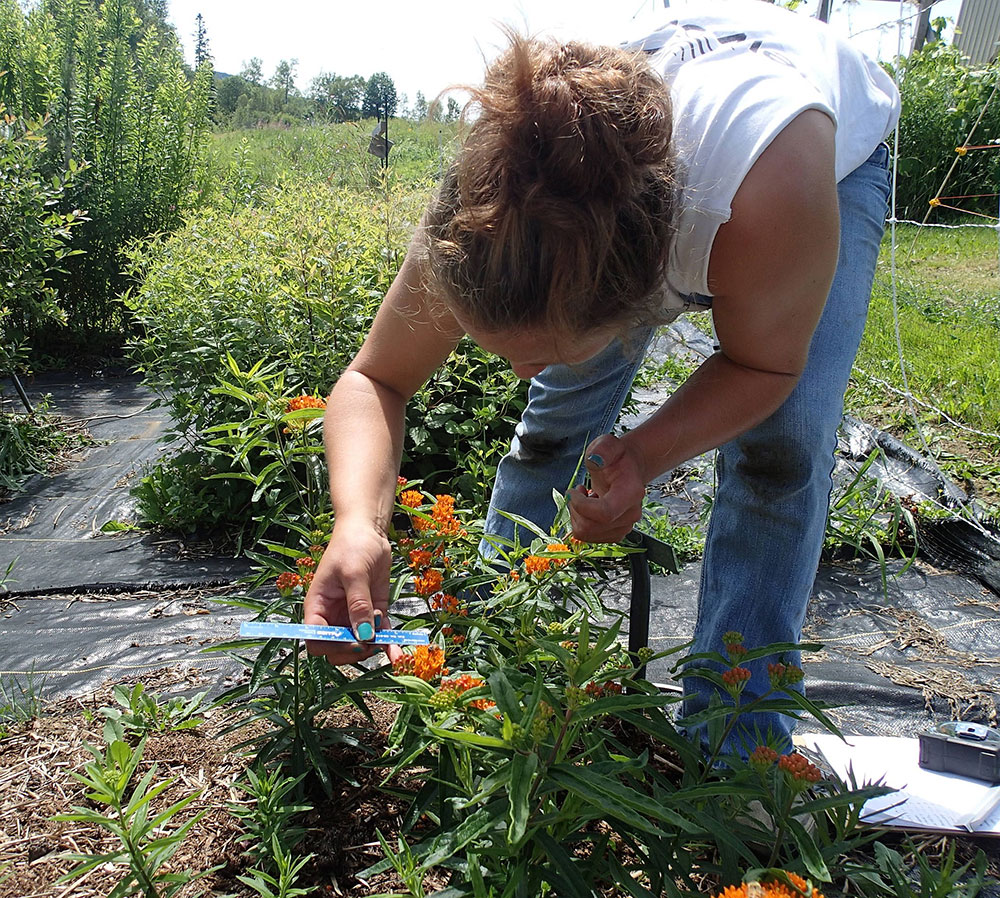
Our observations of bees visiting flowers enabled us to compare the relative attractiveness of the plants because they were grown together in the four gardens (mostly, the same plants in each of the sites) (Fig. 2).
We classified bees into five groups that could be differentiated while they were on open flowers. These groups, which are specifically referred to by these five names in this bulletin, were:
- Honey bees (Apis mellifera, the only non-native bee in this project) (Fig. 3a);
- Most bumble bees (all Bombus species, perhaps up to 12 species, other than Bombus ternarius) (Fig. 3b);
- Orange-belted bumble bee (Bombus ternarius) (Fig. 3c);
- Sweat bees (many are brown or black, others metallic green, more than 50 species) (Fig. 3d);
- Other bees (including digger or sand bees, leafcutter bees, mason bees, cellophane bees, and some others that don’t fit into the other four categories, more than 200 species) (Fig. 3e).


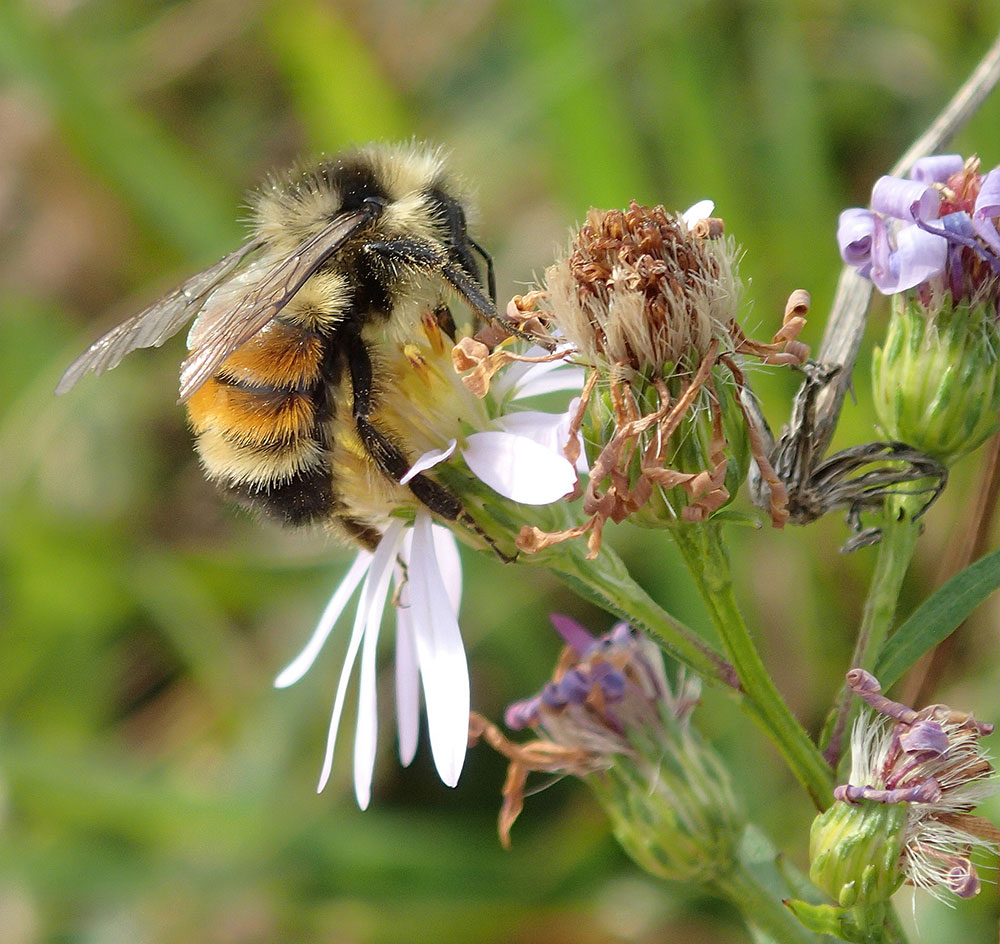
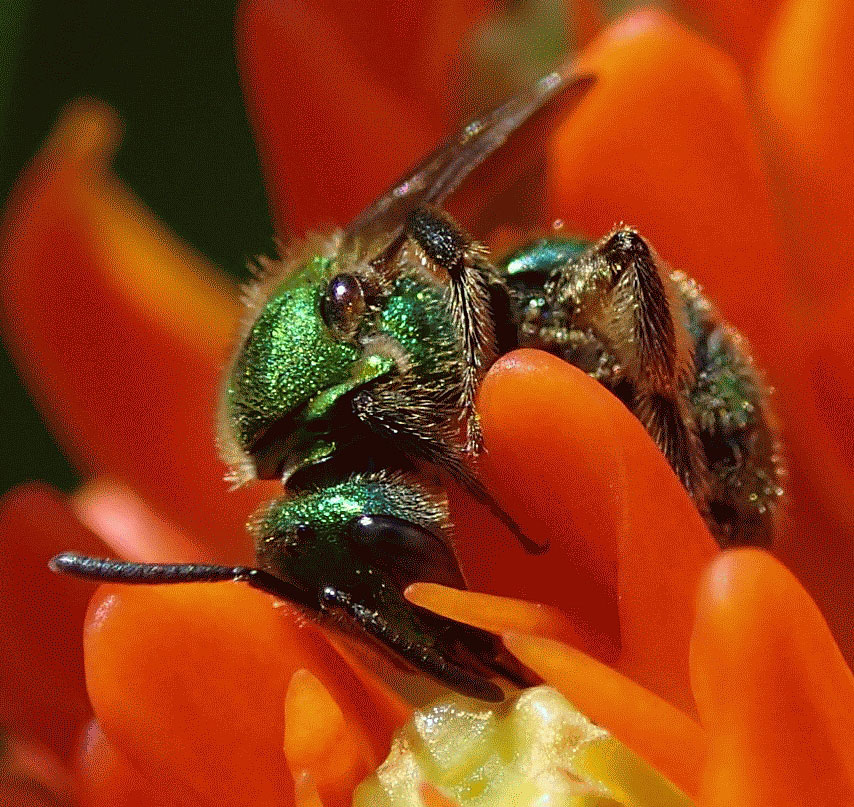

(For more about bees and floral plantings, see the list of Additional Resources at the end of this bulletin).
These observations enabled not only a comparison of bee visitation on flowering plants of many species but we were also able to assess factors that promoted flower use by different bees. We compared wild plants with their hybrids; season of flowering; plant growth form and height; and flower shape, color, size, and corolla tube depth. We addressed questions such as “do native plants attract more bees than introduced plants?” and “do different flower colors and forms attract different bees?”
We visited each site about once a week, in sunny to partly cloudy weather, in calm to light winds. At each visit, we observed each plant species that was in flower for three 1-minute periods and recorded which bees landed on the flowers. We made a total of 14,311 observations during the four years, during which we observed 17,792 bee visits.
See Dibble et al. 2020a and 2020b, listed in Additional Resources at the end of this bulletin, for the journal articles that present the complete data on which this publication is based.
Findings of the Bee Module Project
In general terms, the numbers of bees in the five groups varied from year to year, and from site to site. No one type of plant was uniformly attractive to all groups of bees. In the last year of the study when we collected bees for identification to species, we documented 61 species (22% of Maine’s total bee species!), and they were abundant even in the early stages of the project. The five bee groups were not present in the same proportion at all four sites or in all four years. The Orange-belted bumble bee was particularly numerous at all sites. In more than 60% of the 16 site-year combinations, more than one-third of all observed bees were Most bumble bees and more than 25% of all bees were honey bees. The two groups in which many species are small bees (Sweat bees and Other bees) were present, but overall, they visited flowers in lower numbers than the three groups of larger bees. Additional results are presented in this text and in Table 1, as specific points to help farmers and gardeners start or improve existing bee gardens. We include suggestions for applying what you learn while observing your bee garden, to make it increasingly supportive of bees over time.
We present this information in three sections:
- Broad Recommendations from the Bee Module Project presents practical guidelines drawn from our data, to help in decision-making when developing a bee garden.
- Specific Results of the Bee Module Project presents our research questions, with answers drawn from our data. Our 17,792 separate observations of bees allowed us to group the data in various ways in order to address specific questions about the five groups of bees and the plants they visit.
- Table 1. Bee Plants, Their Flowering Times, and the Rates at Which Bees Visited Them presents a table of our most highly visited plants; their flowering times over the season; and an indication of which bees visited them at low, medium, and high rates. In the first two sections of this bulletin, we use only common names of plants. You can find their botanical names in Table 1.
Broad Recommendations from the Bee Module Project
When designing and maintaining bee gardens you might follow the steps below. We have summarized findings of the Bee Module Project, and included some suggestions for managing your bee garden and improving it over time.
1. Assess the site. Establish your bee garden in full sun to support flower growth and encourage bee activity. Test the soil to determine if it can support good plant growth, or if additions (compost, lime, etc.) might be necessary. Determine if adequate water, in the form of rain and/or irrigation, is available for the first few years after planting shrubs and herbaceous perennials, and for every year if planting annuals. Survey the weeds and invasive plants on the site to assess their potential to compete with the plants you install. Your weed survey will help you design an effective long-term weed management plan. Resolving site problems such as soil inadequacies or aggressive weeds before planting is much easier than trying to correct those same problems after planting. Many bees nest along forest edges, so site location near treed habitat (within 150–300 feet) can enhance those nesting bee populations.
2. Consider whether you will take a general approach, or support specific bees. You can have an effective bee garden without considering specific kinds of bees that you want to support. You could plant a large number of different plants with various traits to support several types of bees. Or, you may wish to develop plantings of fewer types of plants that support one or a few types of bees, such as bumble bees or honey bees. For example, if your primary goal is to provide forage for honey bees, you might plant a large area with a season-long sequence of plants that support them at a high level.
Some bees (honey bees, bumble bees) are active through the entire growing season, while others are active for a shorter time each year; for instance, most digger or sand bees are spring bees. Some bees live in loosely related groups called communes or aggregations or more tightly related social family groups called colonies (carpenter bees, some sand bees, and some sweat bees, among others that are communal; and honey bees, bumble bees, and some sweat bees that are colonial), but most of Maine’s bee species are solitary. Flowers of some plants like white meadowsweet and oregano provide food for many types of bees, but no plant species we studied supports all bees, or flowers for the entire season.
In the Bee Module Project, we considered Orange-belted bumble bee separately from Most bumble bees. The two groups differed in their choice of flowers, and in some other ways as well. It is possible that every kind of bumble bee has unique preferences for plants through the season. If you want to support native bumble bees, you might include plants that have nectar spurs at the base of their flowers, such as columbine and jewelweed.
Bumble bees are generally large, with long tongues, and they feed on deep flowers (as well as other kinds). Spurred flowers can provide nectar for bumble bees whose population might be in decline, with limited competition from smaller bees for the same floral resource. If several species of bumble bees visit your planting, you might find differences among them through frequent observations. If your goal is to protect native bee diversity, you might focus on plants less visited by managed bees (that is, honey bees and commercially available bumble bees and leafcutting and mason bees), to potentially decrease the risk to native bumble bees from exposure to pathogens that are sometimes common in managed bees.
3. Consider both short-term and long-term management. Plants vary in their management needs, both during their establishment period and the longer-term growth and development stage. Always select plants that are adapted to the conditions of your site. It is best to make good plant choices when designing your garden, rather than discovering time-consuming and expensive maintenance challenges that might develop over time.
Shrubs: Select healthy specimens of shrubs, follow good planting procedures, and irrigate the plants during their first few years in order to develop good root systems. Shrubs generally need less maintenance after they are established. Many require only periodic pruning, once every 3-5 years, to maintain a high level of flower production. Be aware that some shrubs, like purpleflowering raspberry and northern bush honeysuckle, expand to form large colonies over time.
Herbaceous perennials: Herbaceous perennials should be irrigated during the first few years after planting, but many require little or no irrigation after that. Most need to be divided periodically, every 3-10 years, to remain productive. Some, like white wood aster, can spread by underground rhizomes, outcompeting nearby plants in just a few years. Still others, like yellow and white sweetclovers and giant blue hyssop, produce large numbers of seeds that cause the colony of plants to expand over time.
Annuals: Annual plants require more maintenance than either shrubs or herbaceous perennials. Generally, annuals must be planted every year. And while many annuals can flower for several weeks, most of them must be deadheaded (spent flowers removed) to do so.
You can reduce your workload by selecting annuals carefully. Three annuals that we tested, common borage, lacy phacelia, and pot marigold, can be grown easily by direct-seeding in the garden. They flower over a long period of time without deadheading, and produce seeds that fall to the ground, overwinter, and produce new plants the following year, thereby reducing or eliminating the need to plant them every year.
4. Select plants that complement those that are already on your site. Your site may already offer abundant bee resources for one or more times of the year. For example, if your site has many asters and goldenrods, you may only need to plant a few additional types of late-season flowers. Or, if your site has maples and willows, you may only need to plant a few types of plants that support bees in early spring. Observe the plants on your site, and take notes that help you decide what other plants to add. You can identify times when few plants flower, and which species of plants don’t perform as well as you want, so that you can add/replace plants to make the garden more effective.
5. For a bee garden that supports the greatest diversity of bees, select bee-visited plants that flower in a continuous succession from early spring until hard frost. In trying for a continuous succession of flowering plants, include some plants that have long flowering duration (e.g., white meadowsweet), and some that may fill gaps in flowering among the plants that are already on your site.
Not every flowering plant attracts many bees. Among the most-visited plants in the Bee Module Project were butterfly milkweed (Fig. 4b), white meadowsweet (Fig. 4e), coastal sweetpepperbush (Fig. 4a), common borage, yellow sweetclover, and several members of the Aster Family (Table 1). Each bee group ranked plants uniquely; that is, not many plants appealed to all bee groups more or less equally. For example, Other bees especially visited early-flowering shrubs, Sweat bees visited black chokeberry most frequently, and all bees together most frequently visited yellow sweetclover (June), butterfly milkweed (July), and coastal sweetpepperbush (August).
Native plants from the Bee Module Project that produced flowers for a prolonged period include especially white meadowsweet, and to a lesser extent butterfly milkweed, swamp rose (Fig. 4d), and coastal sweetpepperbush. Introduced plants that flowered for a long period in the Bee Module Project include oregano (Fig. 4c), French marigold when deadheaded, and foxglove beardtongue.
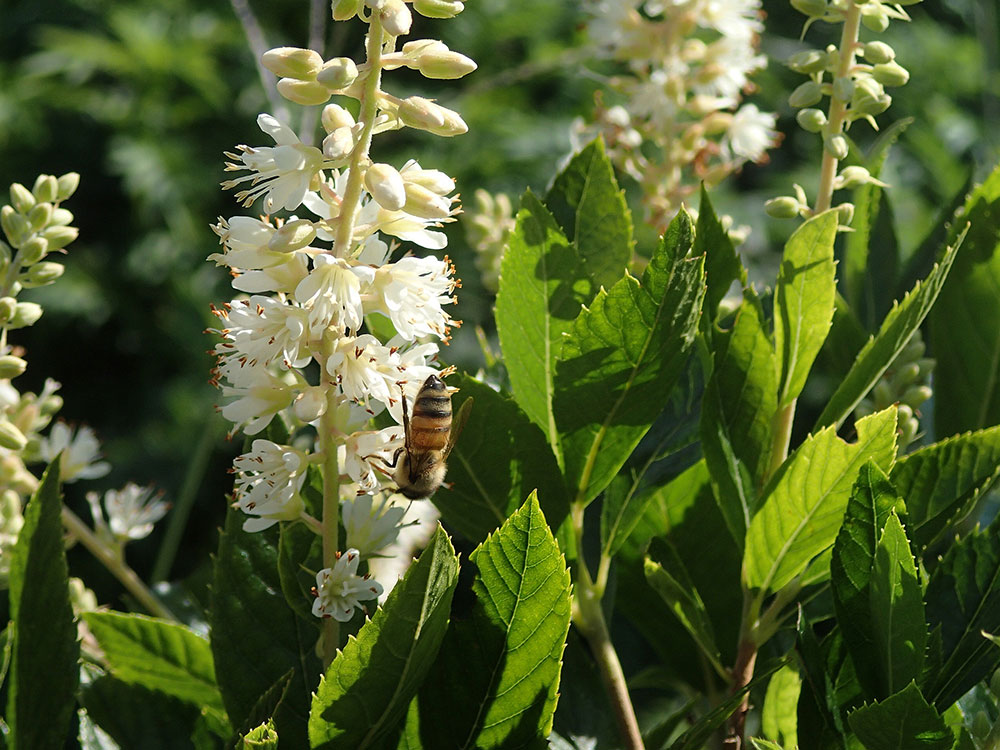
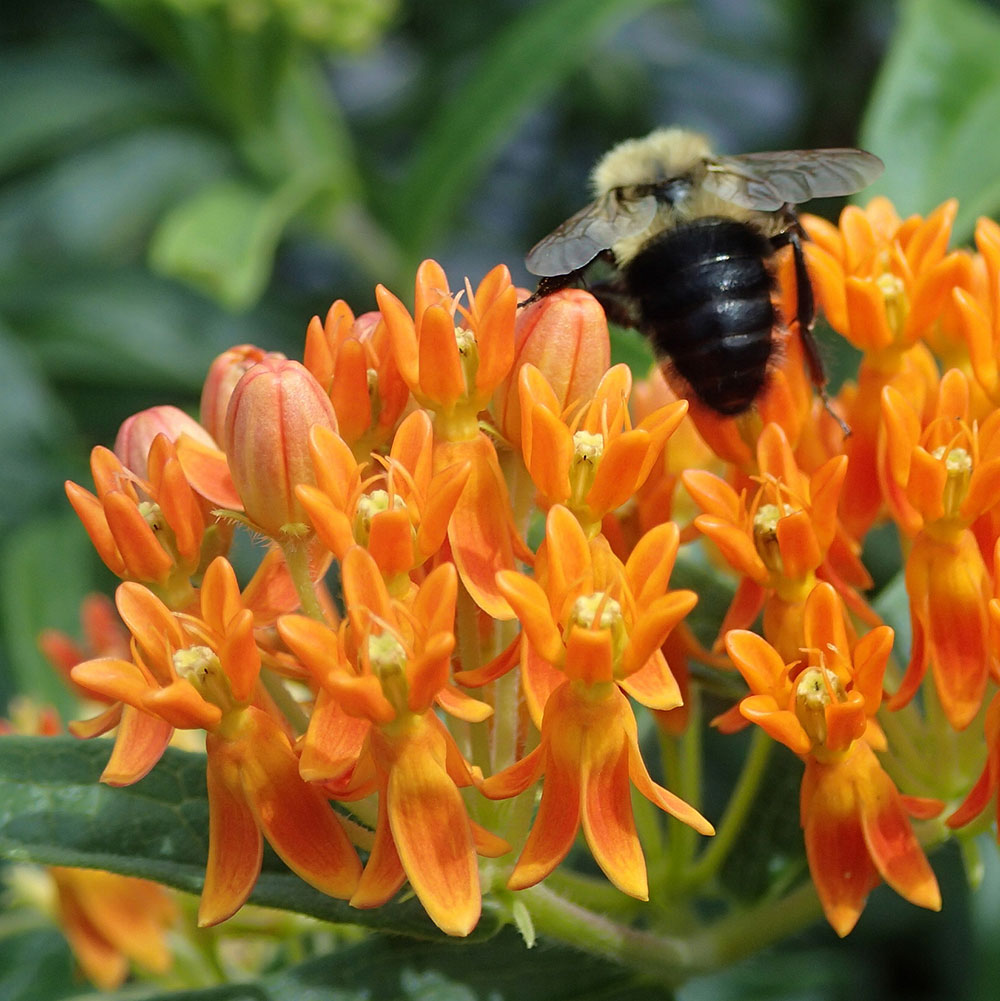
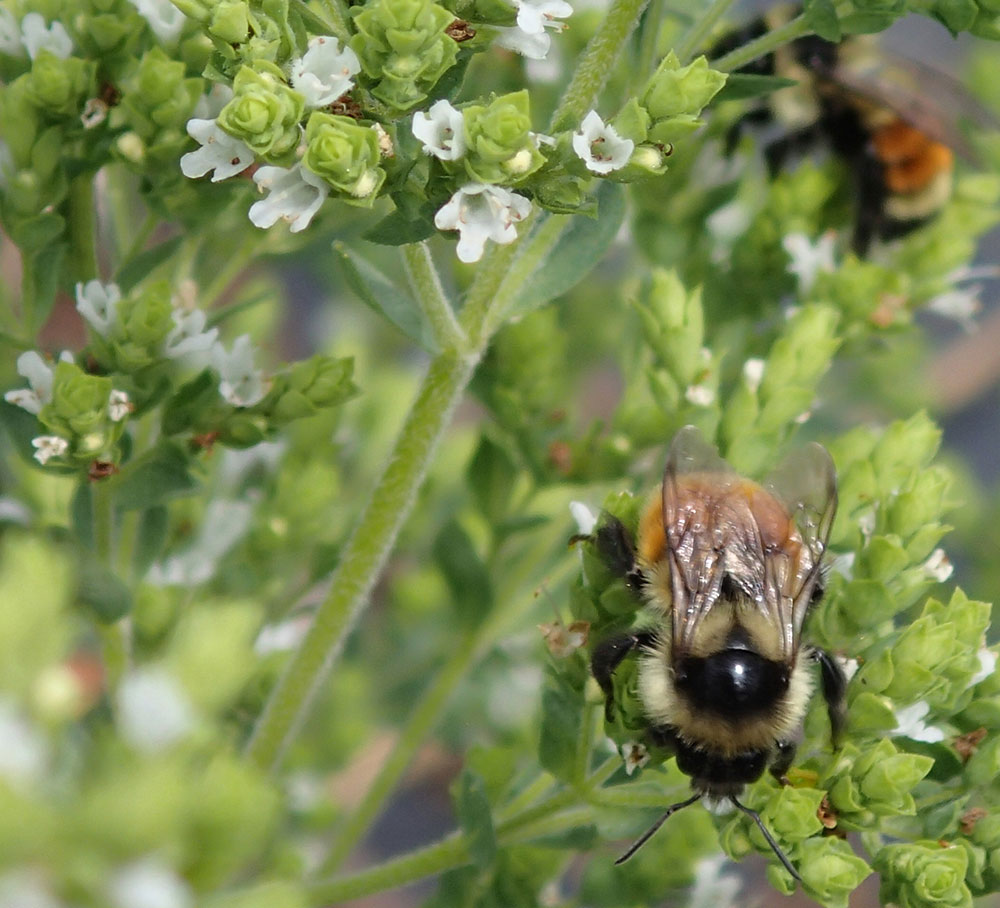


6. Consider your bee garden a long-term project that evolves as you apply what you learn from it. The relationships between insects and plants are numerous and complex. The Bee Module Project addressed many questions, but did not assess quality or quantity of pollen, nectar, oils, and fragrances. These features are part of the big picture of bee foraging, and can vary with time of day, temperature, relative humidity, wind speed, and other aspects of the environment.
Many of Maine’s bees are generalist feeders. When a “favored plant” is not available to them, they feed on another plant. Also, local bee populations vary from year to year, so a plant that you find to be very attractive to bees in one year could be so in another year, though there are exceptions. We offer what we learned from the Bee Module Project as documentation of what occurred at four sites over four years. Your site may differ enough that you’ll find different bee visitation patterns on the same plants. Also, by checking nearby wild places and asking gardening neighbors, you might identify bee support plants that perform well in your specific area.
Learning about bees can engage you for many years, and you will constantly learn new things from your observations. What you learn will inform your future plant choices, help you improve your management methods, and support bees more effectively over time.
Specific Results of the Bee Module Project
Through analysis of our observations in the Bee Module Project, we were able to characterize bee visitation of flowers in many ways. Each of our 13 results below is followed by a “take-home message” that you can use in your own bee garden.
Result #1: “Build it and they will come.” We were surprised at the number of bees that came to the gardens even in the first year of the four-year study, suggesting that bees were already in the environment in abundance. They responded immediately at all four sites to the increases in floral resources. It matters that the plants you include are those that attract bees. But flower color, fragrance, amount of pollen produced, and amount of nectar might make relatively little difference on a coarse scale.
Take-home message: Go ahead and design your garden; it will make a difference.
Result #2: Not all members of a plant family attract bees equally. Bee garden guidelines often suggest planting members of particular plant families. We studied five shrubs in the Rose Family for 3-4 years at each of our four sites: ‘Regent’ Saskatoon serviceberry, ‘Viking’ black chokeberry, swamp rose, purpleflowering raspberry, and white meadowsweet. The most visited of these plants for all bees together was white meadowsweet, while the Saskatoon serviceberry displayed the lowest bee visitation rate, significantly lower than the white meadowsweet. Honey bees and Most bumble bees visited all five shrubs at the same rate, and not different from each other. Orange-belted bumble bee visited the white meadowsweet at the highest rate, the raspberry and rose at intermediate rates, and the chokeberry and serviceberry at low rates. Other bees visited all five shrubs at comparatively low rates.
Take-home message: Many bee plant lists advise gardeners to choose plants of particular families. That may be generally true for the Rose, Mint, and Aster Families, but not all plants within those families attract bees at a high rate, as evidenced by our data of shrubs in the Rose Family. It’s a good idea to visit bee gardens, read science-based literature, and talk to other gardeners when choosing specific plants for your bee garden. In general, the more local the recommendation, the more likely it will accurately predict what you will see in your own garden.
Result #3: Bee visits change from one time of day to another, for some but not all bees or all plants. If you have planted buckwheat as a cover crop in your vegetable garden, you may have noticed that some bees forage heavily on it in the morning, but not in late afternoon. But it would be a mistake to generalize this time-of-day bee foraging. We compared seven plants for time-of-day foraging by the five bee groups: butterfly milkweed, coastal sweetpepperbush, white wood aster, yellow sweetclover, white-flowered oregano, swamp rose, and white meadowsweet. Our time categories were morning (before 11:00 a.m.), mid-day (11:00 a.m.–2:00 p.m.) and afternoon (after 2:00 p.m.). We found little difference in the times bees visited most of these plants. Honey bees, Orange-belted bumble bee, Sweat bees, and Other bees showed no change in their visitation rates for any of the plants, across the daily time periods. Most bumble bees visited all seven plants at significantly higher rates before 2:00 pm, and their visitation rate on swamp rose dropped steeply after 2:00 pm. Most bumble bees visited butterfly milkweed, swamp rose, and white meadowsweet at higher rates in the morning, while Other bees visited white wood aster at the highest rates in mid-day and afternoon. Bees may change their preferences for some plants over the course of a day, probably in response to nectar flow.
Take-home message: Information about timing of bee visits could be important to someone who needs to avoid bees due to allergies, or it could help a bee photographer to stake out a location ready for action!
Result #4: Plant preferences for some bees may change over the course of the season. We assessed 36 kinds of plants that flower in June, July, and August to determine if some bee groups preferred some plants in one month more than another. Some bee groups visited particular plants more in one month than another month, but Sweat bees and Other bees did not visit plants at different rates across the three months. When we considered all of the bees together, we found that yellow sweetclover was among the three most visited plants in June, July, and August, and butterfly milkweed was among the three most visited plants in July and August. In at least four instances for specific bee groups, the following plants had highest visitation rates in a given month, in descending order: garden thyme, yellow sweetclover, raceme catnip, foxglove beardtongue, black chokeberry, butterfly milkweed, and Icelandic poppy.
Take-home message: Some gardeners are concerned that honey bees might outcompete native bees on the native plants in their landscape. Our test concluded that competition between honey bees and all these other bee groups is not significant. We did find that in August, coastal sweetpepperbush, northern bush honeysuckle, spotted joe pye weed, and downy goldenrod, all native or nearly so, were among the plants that attracted honey bees. This suggests that during some times of the growing season, honey bees probably compete with native bees for nectar and pollen of native plants. We found that honey bees visited plants, including native plants, that the other groups also visited. For honey bees, thousands of worker bees might visit a given plant species when nectar flow is high, and they have potential to compete with native bees for those floral resources. However, we did not observe decreased visitation to flowers by native bees as honey bee visitation increased on specific plant species that we observed over a four-year period. If we had, this would have indicated an effect of competition on native bees by honey bees. We also did not directly observe conflicts between honey bees and native bees, and both types of bees were often together on the same flowers. Honey bee visitation increased with increased visits by Most bumble bees and Orange-belted bumble bee, suggesting that bee tongue length could be a factor in the selection of flowering plant species with long tubular corollas, since these bees all have longer tongues than do Sweat bees and many of the Other bee species.
Result #5: Some bees visit one plant species repeatedly, while others do not. We analyzed 80 different plants for the “flower faithfulness” of our five bee groups, while the number of plants we included in other analyses varied from this. We found that honey bees were associated with coastal sweetpepperbush. Other bees were associated with willows and ‘Regent’ Saskatoon serviceberry. Sweat bees were associated with Icelandic poppy. Multiple bee groups were associated with yellow sweetclover.
Take-home message: Repeated observations over time are needed to assess flower faithfulness. Some plants might have long flowering periods, and be more attractive in some situations and in different geographic areas. Temperate-zone bees, which are largely generalists, visit multiple host plants even during one flight as a way to find alternative flowering plants for when their preferred resource passes out of flower.
Result #6: Plant origin (native vs. introduced) affects bee visitation to some degree. We observed bees on 17 native plants and 68 introduced plants to find patterns of how plant origin affects bee visitation. None of our five groups of bees visited exclusively either native or introduced plants. The four groups of native bees visited native plants at significantly higher rates than they visited introduced plants with some exceptions, while Honey bees visited native and introduced plants at similar rates. Orange-belted bumble bees visited the 17 native plants at a significantly higher rate than they visited the 68 introduced plants, while Most bumble bees visited the two groups of plants at similar rates. Other bees visited native early-flowering plants at the highest rate.
Take-home message: It might be tempting to support native bees by planting only native plants. But Honey bees would be likely to forage on at least some of those plants, perhaps competing against the native bees in situations of limited food supply. It might also be challenging to find enough native plant species at garden centers to provide a continuous supply of nectar and pollen over the whole season.
Result #7: Flowering season influences bee visitation. We could find no plant species that flowers all season long. Average flowering times in the Bee Module Project were 56 days for annuals, 42 days for herbaceous perennials, and 25 days for shrubs, and these times were spread from early spring through late fall. Most groups of bees visited native late-flowering and native mid-late-flowering plants at higher rates compared to native spring flowering plants and introduced plant species independent of flowering season. Honey bees, Orange-belted bumble bees, and Most bumble bees visited long-flowering native plants at high rates. Other bees visited long-flowering introduced plants at high rates.
Take-home message: Seasonality of flowers is an important consideration when choosing plants for a bee garden. Some of the most important crop pollinators, including bumble bees and honey bees, need forage from April until hard frost in the fall. By choosing plants with overlapping flowering seasons, the bee garden can supply their needs. On the other hand, because some native bees are active for only a few weeks each year, plants must flower during this short time in order to support them.
Result #8: Flower height influences bee visitation. Overall, bees were attracted to tall plants, both native and introduced. Orange-belted bumble bees visited taller flowers regardless of whether they were native or introduced, while Most bumble bees visited taller native flowers at higher rates, but not taller introduced flowers. Sweat bees visited flowers without regard for height. Honey bees were attracted to taller introduced flowers, and lower-growing native flowers.
Take-home message: Flower height might be of secondary importance to other plant attributes.
Result #9: Plant form (annual, herbaceous perennial, or shrub) influenced bee visitation. Overall, bees were attracted to native perennials, introduced perennials, and native shrubs, but plant form did not influence Most bumble bees and Sweat bees. Introduced shrubs and native annuals received the lowest visitation. Orange-belted bumble bees showed no preference among introduced plants, but among native plants they visited perennials at the highest rate, and annuals and shrubs at the lowest rates. Other bees visited native shrubs at the highest rate, and all other growth forms, both native and introduced, at a low rate.
Take-home message: If your garden site has some native shrubs, observe them in flower. You may find that they are already supporting bees. One of the authors, Dr. A. C. Dibble, has found that a diverse community of bees is attracted to many species of shadbush (Amelanchier). When selecting plants for your bee garden, note that our findings about native annuals were based on the only native annual in the study, rock harlequin. Maine has relatively few native annual plants, but you might want to try a few of them to determine if they attract bees. An example is jewelweed (Impatiens capensis), which attracts bumble bees and also hummingbirds.
Result #10: Wild plants may differ from their hybridized forms in attracting some bees. In the Bee Module Project, we compared a wild type and a hybrid within each of these species: golden tickseed, Indian blanket, common sunflower, butter and eggs, Icelandic poppy, and French marigold. Most bumble bees visited wild-type Indian blanket at a higher rate than the cultivar. All bees combined, and specifically Honey bees, Most bumble bees, and Orange-belted bumble bees, visited wild-type French marigold at a higher rate than its hybrid.
Take-home message: Consider each plant species individually to determine if a wild type or a hybrid attracts bees at a higher rate. Even within one plant species, hybrids vary in the amount of bee forage they provide. For example, floral nectaries might be eliminated, and pollen-bearing stamens might be eliminated or rendered sterile during development of double-flowered hybrids, compared to single-flowered hybrids. Floral features that attract people are usually not the same features that attract bees.
Result #11: Flower shape affects bee visitation rates. We compared bee visitation rates on various shapes of flowers. We found that Orange-belted bumble bees visited the uniquely shaped flowers of milkweed at a high rate, compared to flowers with different shapes, including cup-shaped and tubular. Sweat bees and Other bees did not show this high visitation for milkweed compared to other flower shapes. Honey bees showed a preference for mustard-type flowers over tubular flowers, and Other bees preferred cup-shaped flowers to tubular flowers. Willows have pendulous catkin flowers that we found to be an important early-season source of pollen for Other bees. Bell-shaped flowers showed low visitation rates, with only Orange-belted bumble bees and Most bumble bees visiting bell flowers at discernible levels.
Take-home message: Our findings suggest that more kinds of bees are supported where many shapes of flowers are available.
Result #12: Flower color affects bee visitation rates. People and bees perceive flower color differently, making it difficult to confidently select plants with a flower color that attracts specific bees. We found that Honey bees visited plants with white or pink flowers more than those with yellow or red flowers. Orange-belted bumble bees visited plants with purple or pink flowers more than those with blue flowers. Sweat bees visited white-flowered plants more than plants with yellow, red, or blue flowers. Other bees visited white-flowered plants more than those with purple or red flowers. However, keep in mind that people detect a different visual light spectrum than bees do. For instance, most bees see in the ultraviolet range, which is invisible to us, and some bees do not detect red distinctly as we do. But this gets confusing because red flowers with ultraviolet markings are well recognized by bees. Examples of this phenomenon are common beebalm and some cultivars of snapdragons and zinnias.
Take-home message: Our findings suggest that a variety of flower colors is likely to attract a variety of bees.
Result #13: Other plant traits influence bee visitation rates. Bees use many plant cues to make their food choices. Among the variables we studied were flower diameter, closest distance between flowers, distance between flower clusters, corolla tube depth, and number of days of flowering. Regarding individual bee group visitation patterns, we found that for all bee groups other than Orange-belted bumble bees, the longer the flowering season, the higher the visitation rate; for all bee groups other than Sweat bees, visitation was higher on taller plants; for Orange-belted bumble bees and Sweat bees, the nearer the closest flower (floral density), the higher the visitation; for Honey bees, the larger the flowers, the higher the visitation; for Most bumble bees, greater flower depth yielded greater visitation. In general, a greater density of flowers per volume of plant yielded higher visitation rates, and small dense clusters of flowers produced higher visitation rates than sparse flowers.
Take-home message: In general, taller plants with dense clusters of flowers that are available over a long time may be especially effective for the bee garden. Examples are white meadowsweet, coastal sweetpepperbush, and some of the spring-blooming fruit trees and shrubs.
Summary
Our overall conclusion is that flowering plant diversity is key to supporting a diverse bee community, but lessons that we have learned suggest that specific selections that make up that flowering plant diversity may have a large effect on bee visitation and subsequent bee health. Some of the plants listed in Table 1 may already be growing near your bee garden, and could function in a synergistic manner with your garden, creating a greater effective habitat. Act locally! Bee communities vary in species composition and abundance from one neighborhood to the next. Wild flowering plant communities also differ from place to place, even within distances of hundreds of yards. Added to this heterogeneity, some bees forage for plants over distances of a few miles (honey bees, bumble bees, and large cellophane bees), while some bees forage only within 50–100 yards of their nest (small carpenter bees and sweat bees). These “landscape” phenomena of plants and bees ensure that you may observe many of the same bee/flower interactions that your neighbors do, but it is almost certain that you will also see very different slices of pollinator/plant natural history.
Planting bee gardens will help save bees from extinction if enough of us take part. At the University of Maine, we have documented that this activity can increase native bee abundance in commercial blueberry fields, and we are certain that home gardens can have the same impact. In ending, we would also like you to remember that bees are just ONE piece of the picture. Planting flowering plant gardens will help other members of the pollinator community: birds, butterflies and moths, flies, beetles, wasps, ants, and true bugs. Even their enemies, predators, and parasites are important; we need fully linked animal and plant communities to result in stable and functional ecosystems. So look for these pollinators and their associates in your bee garden, learn about them, and help your garden visitors learn, too!
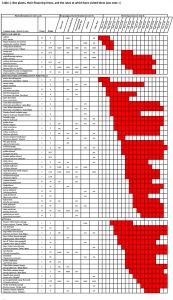 Table 1. Bee plants, their flowering times, and the rates at which bees visited them
Table 1. Bee plants, their flowering times, and the rates at which bees visited them
Additional Resources
1. Bee Gardens and Landscapes:
Dibble, A.C., A.L. Averill, K. Bickerman-Martens, S.C. Bosworth, S. Bushmann, F.A. Drummond, J. Fowler, A.K. Hoshide, M.E. Leach, K. Skyrm, E. Venturini, and A. White. 2017. Bee habitat in Northern New England (PDF). MAFES Misc. Report. 448, 50 pp.
Dibble, A., F. A. Drummond, and L.B. Stack. 2020a. Bee visitation on flowers in Maine, United States, reveals the relative attractiveness of plants through space and time: Part I. Environ. Entomol. 49(3):726-737.
Dibble, A., F. A. Drummond, and L.B. Stack. 2020b. Plant origin and other attributes impact bee forage patterns in a common garden study in Maine, United States; Part II. Environ. Entomol. 49(3):738-752.
Neal, C. 2019. Planting for pollinators: Establishing a wildflower meadow from seed. University of New Hampshire Cooperative Extension, Durham, NH.
Stack, L.B., F.A. Drummond, and A. Dibble. 2013. How to create a bee-friendly landscape. Fact Sheet 243, Univ. Maine Coop. Ext. no. 2007. University of Maine Cooperative Extension, Orono, ME.
Stack, L.B., F.A. Drummond, and A. Dibble. 2013. The buzz about bee gardens. Maine Home Garden News—May 2013. University of Maine Cooperative Extension, Orono, ME.
Venturini, E.M., F.A. Drummond, A.K. Hoshide, L.B. Stack, and A.C. Dibble. 2015. Enhancing wild bees for crop pollination: Sowing bee pasture for New England’s wild lowbush blueberry (PDF). University of Maine Cooperative Extension, Orono, ME.
2. Bee Conservation:
Drummond, F.A., and C.S. Stubbs. 2003. Wild bee conservation for wild blueberry fields. University of Maine Cooperative Extension Fact Sheet 630. 12 pp.
3. Bee Identification Resource for Northern New England:
Odanaka K., J. Hall, S. Nooten, and S. Rehan. 2018. Wild Bees of New England: A Guide to Common Pollinators & Flowers (PDF). University of New Hampshire. 120 p.
Odanaka, K., J. Hall, S. Nooten, and S. Rehan. 2020. Wild Bees of New England. University of New Hampshire.
Funding Sources
This research was made possible through support from the Maine Agricultural and Forest Experiment Station, a USDA/National Institute of Food and Agriculture Specialty Crop Research Initiative Grant 2011-01389, the University of Maine, the Maine Agricultural Center, New England Grows, the Wild Blueberry Commission of Maine, and New England Floriculture, Inc. Seed and plant sources included Ball Seed Co., West Chicago, IL; Ernst Conservation Seeds, Meadville, PA; Dr. Jaime Mena-Covarrubias, Instituto Nacional de Investigaciones Forestales Agricolas y Pecuarias, Zacatecas, Mexico; Susan Stieve, Ornamental Plant Germplasm Center, The Ohio State University; and the GRIN National Genetic Resources Program.
Acknowledgments
We had help in establishing three of the experimental gardens (BBHF, CURT, FOUR) from Joshua Stubbs and Christopher McManus of the Blueberry Hill Farm crew for the University of Maine, under direction of Jeffrey Brann, Farm Manager, and at ROGE from Joe Cannon, Farm Manager. Drs. Aaron Hoshide and Eric Asare also helped establish our initial plantings. Kate Garland, Penobscot Co. Extension Horticulturist, provided garden space for ROGE in the Penobscot County Master Gardener Garden. We thank Dr. John S. Ascher, Michael Veit, and Dr. Leif Richardson for identifying bees collected as vouchers for this study. Eric Venturini contributed to study design discussions in 2012. Field data were collected by ACD and FAD with assistance from Christian Beauregard, Martha Brill, Peter Hanlon, Megan Leach, Margaret McCollough, Amanda Pelletier, Eric Venturini, Caitlin Vogel, Sarah Watt, and Sadie Wight. Martha Brill assisted with data management in 2014. Philip Stack provided plant production and maintenance assistance.
Information in this publication is provided purely for educational purposes. No responsibility is assumed for any problems associated with the use of products or services mentioned. No endorsement of products or companies is intended, nor is criticism of unnamed products or companies implied.
© 2020
Call 800.287.0274 (in Maine), or 207.581.3188, for information on publications and program offerings from University of Maine Cooperative Extension, or visit extension.umaine.edu.
In complying with the letter and spirit of applicable laws and pursuing its own goals of diversity, the University of Maine System does not discriminate on the grounds of race, color, religion, sex, sexual orientation, transgender status, gender, gender identity or expression, ethnicity, national origin, citizenship status, familial status, ancestry, age, disability physical or mental, genetic information, or veterans or military status in employment, education, and all other programs and activities. The University provides reasonable accommodations to qualified individuals with disabilities upon request. The following person has been designated to handle inquiries regarding non-discrimination policies: Director of Equal Opportunity, 5713 Chadbourne Hall, Room 412, University of Maine, Orono, ME 04469-5713, 207.581.1226, TTY 711 (Maine Relay System).

